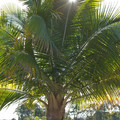Branded the "island continent", Australia is known for its beautiful and varying landscapes. From the deep, blue waters that house the Great Barrier Reef, the world's largest reef system, through the 60 million year old wilderness of the Tropical Rainforest, to the dramatic cliffs and canyons of the Blue Mountains, Australia is home to vastly different manifestations of nature.
However, with all of the beauty of what is seen as Mother Nature's canvas, there comes great responsibility for its care. Hostile species, such as certain types of birds, weeds, and bugs are a grave threat to the Australian landscape.
One out of a few of the significant threats to the health and beauty of Australia's natural environment is weeds. Australia spends roughly $3.5 billion each year in the management of weeds by attempting to protect Australia's landscape and fighting the spread of weed seeds in order to preserve natural environments.
Due to the large production of its seeds, weeds have the ability to inhabit all environments including Australia's oceans, deserts, and alpine areas. According to the Australian Government, there are several species of weeds that are of national concern and have been listed on several eradication lists including the Australian Government's own National Environmental Alert List.
Preventing, rather than reacting, is the most effective way to prohibit the infestation of weeds. Due to the large amount of seeds produced, it can be difficult to banish weeds from an area once they have been established in that area.
On their website, the Australian Government lists several steps for the prevention of weed infestations including:
- Choosing plants for your backyard that are unlikely to become weeds
- Removing potentially weedy plants
- Utilize mulch in your garden to reduce the growth of weeds
- Carefully dispose of any garden waste so as not to spread seeds from the remove weeds
Weeds are not the only concern for gardeners looking to grow and cultivate their gardens. Invasive birds including the Indian Mynah, the Common Starling, and the Rock Pigeon, have also earned a negative reputation among horticulturists.
After initially being introduced to help with the control of locust infestations, these birds overstayed the welcome with unhealthy behaviors. Now the Indian Mynah, not a bird local to Australia, has been placed on the Conservation Union's "Worst Invasive Species" list for spreading disease and mites and with the bullying of local birds by forcing them from their nests.
Black birds are also a common problem for homeowners with private gardens. Black are notorious for moving around mulch and making the garden aesthetically unpleasant.
Although there is yet to surface, one concrete solution to the problem, some favorite scare tactics of homeowners have been to:
- Post artificial snakes around the garden area
- Support your garden with gravel rather than mulch to prevent the black birds from tossing it around
- Surround the garden with six-foot high mesh fencing to prevent the entry of the birds
Finally, there are several insects that are harmful to Australia's beautiful nature. Of those noted by the government, the White Snail and the Fire Ant are the most common problems to the fellow gardener. Large numbers of White Snails collect in a single area and climb to the top of vegetation or fences and aestivates. This remains and issues because these snails are a host to a specific type of parasite that causes serious health issues in humans.
Fire ants are also a severe nuisance to ecological well-being. Fire Ants build on soil close to homes and buildings and feed on vegetable plants in home gardens. They are at their worst during hot dry weather. During this climate they tend to invade flowerbeds in order to seek warmth.
With the government and researches still trying to learn more about prevention of the spread of these insects, it is suggested to reach out to your local nursery on possible means of removing these insects from your garden.
With a few solutions to current biological enemies existing in the gardens of Australians all over the continent, researchers are always looking for ways to control the issues. The Australian Government hosts a wealth of information on its site about the various invasive species and methods of removal.
<< Previous Playing Horticultural Cupid: The In's and Out's of Pollination | Back to Mullumbimby Palm Blog | Next >> Some of the Common Naturally Occurring Australian Palm Trees



